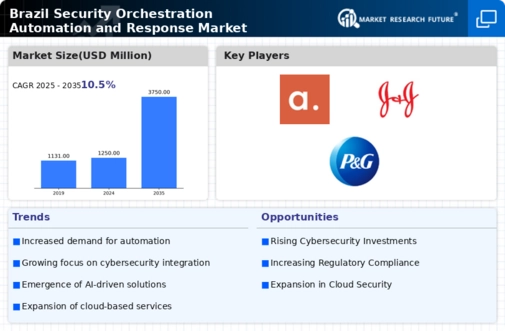Market Growth Projections
The Global Brazil Security Orchestration Automation and Response Market Industry is projected to experience substantial growth over the coming years. With a market size of 1250 USD Million in 2024, the industry is expected to expand significantly, reaching 3750 USD Million by 2035. This growth trajectory reflects a compound annual growth rate of 10.5% from 2025 to 2035, driven by increasing cybersecurity threats, regulatory compliance demands, and advancements in technology. The market's evolution indicates a robust demand for security orchestration solutions that enhance organizational resilience against cyber threats.
Rising Cybersecurity Threats
The increasing frequency and sophistication of cyber threats is a primary driver for the Global Brazil Security Orchestration Automation and Response Market Industry. As organizations face advanced persistent threats and ransomware attacks, the need for automated response solutions becomes paramount. In Brazil, the number of reported cyber incidents has surged, prompting businesses to invest in security orchestration tools. This trend is expected to contribute to the market's growth, with projections indicating a market size of 1250 USD Million in 2024. Companies are recognizing that proactive measures through automation can mitigate risks and enhance their security posture.
Regulatory Compliance Requirements
Stringent regulatory frameworks in Brazil are compelling organizations to adopt security orchestration automation and response solutions. Compliance with laws such as the General Data Protection Law (LGPD) necessitates robust data protection measures. The Global Brazil Security Orchestration Automation and Response Market Industry is likely to benefit from this compliance-driven demand, as organizations seek to automate their security processes to meet regulatory standards. The anticipated growth trajectory suggests that by 2035, the market could reach 3750 USD Million, driven by the need for continuous monitoring and reporting to adhere to evolving regulations.
Increased Investment in Cybersecurity
The growing recognition of cybersecurity as a critical business function is driving investment in the Global Brazil Security Orchestration Automation and Response Market Industry. Organizations are allocating larger budgets to enhance their security infrastructure, particularly in response to high-profile breaches. This trend is evident in Brazil, where businesses are prioritizing cybersecurity initiatives to protect sensitive data and maintain customer trust. As a result, the market is poised for substantial growth, with expectations of reaching 3750 USD Million by 2035. The influx of capital into cybersecurity solutions underscores the importance of effective orchestration and automation in safeguarding digital assets.
Integration of AI and Machine Learning
The integration of artificial intelligence and machine learning technologies into security orchestration is transforming the Global Brazil Security Orchestration Automation and Response Market Industry. These technologies enhance threat detection and response capabilities, allowing organizations to analyze vast amounts of data in real-time. Brazilian companies are increasingly adopting AI-driven solutions to streamline their security operations and improve incident response times. This trend is indicative of a broader global movement towards intelligent security systems, which may contribute to a compound annual growth rate of 10.5% from 2025 to 2035, reflecting the growing reliance on advanced technologies in cybersecurity.
Demand for Real-Time Threat Intelligence
The demand for real-time threat intelligence is shaping the Global Brazil Security Orchestration Automation and Response Market Industry. Organizations are increasingly seeking solutions that provide immediate insights into emerging threats, enabling them to respond swiftly and effectively. In Brazil, the proliferation of digital services has heightened the need for timely threat information, prompting businesses to invest in orchestration tools that integrate threat intelligence feeds. This trend is likely to drive market growth, as companies recognize the value of proactive threat management in an evolving cyber landscape.














Leave a Comment